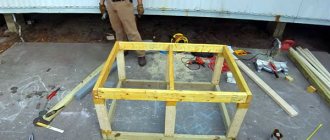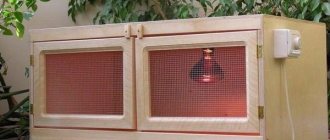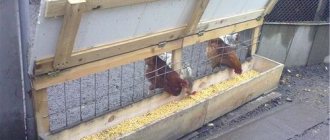Chicken farming begins with hatching and raising chicks. The hen does an excellent job of raising the chicks and teaching them independence. But it is not always possible to raise a laying hen for eggs, and many modern highly productive breeds of egg and meat chickens, as well as crosses and hybrids, have lost their natural ability to breed offspring. In this case, chickens are hatched by incubating eggs or purchasing day-old chicks.
Raising chicks without a broody requires preliminary preparation. For the first month, broiler chickens and future laying hens are usually kept in a brooder - this will guarantee their survival and normal development.
This is a cage in which the babies will be provided with optimal conditions for keeping, feeding and watering. For the first time, you can adapt an ordinary box for chickens, but it is difficult to maintain such important parameters as temperature and humidity, and maintenance will be inconvenient. Therefore, it is best to buy a ready-made brooder or make one yourself to keep chickens at home - in an outbuilding, poultry house, barn and even in the house.
Brooders with a metal frame on the balcony
By the way, the name brooder comes from the English word brood, which means hen.
Blueprints
Important points of cultivation
Of course, nothing can replace the mother hen with greater efficiency, but there are examples of farms that properly equipped cages and raised healthy offspring.
For this you will need:
- the correct temperature regime so that babies don’t randomly look for warmth on each other and end up suffocating
- cool houses will reduce the appetite of the inhabitants, hot ones will increase thirst and reduce the mobility of young animals
- from rational heating, chicks quickly gain weight, as they eat properly and move
Regular supply of chicks with water, feed, and vitamins will allow them to raise healthy offspring.
The influence of lighting on the health of young animals
Lighting in the box for young animals
Physiologically, the bird is very sensitive to light illumination.
She has good visual acuity, but only in bright spaces; she becomes completely blind in the dark.
This is used by breeders to regulate the feeding process, chicken activity, and the time period of wakefulness and sleep.
With the intensity of light fluxes, a farmer can achieve:
- improving the search for water and feed for day-old chicks
- reducing emergency situations
- increase in height
- weight gain
- causing shedding in adults
- control over pullet development
In addition to the above, breeders in the poultry house operate with temporary illumination to observe the process:
- quantitative food consumption
- puberty with the onset of egg production
- in summer, the heat produced by birds is regulated
Two-tier cage for young animals
Careful housekeepers create a lighting program that includes various blocks with intermittent or continuous darkness.
Raising broiler or laying hens takes place with different programs, but it is necessary to ensure a dark period so that bone tissue is formed, calcium is exchanged, and immunity is developed.
Maintenance of a light poultry house occurs with great convenience - this is also useful for its inhabitants. If the chicken coop is large, then arrange lines of lamps.
When chickens are raised in cages, the installation of lighting fixtures is carried out in the aisles at a height sufficient to easily change burnt-out lamps and at the same time they should not interfere with movement.
Light illumination in broilers and layers differs not only in duration, but also in intensity. Day-old chicks of all species need constant brightness, with long daylight hours - this helps them quickly adapt to the world.
Chicks are provided with round-the-clock lighting for the first 10 days. Then the light is reduced and at 2 months 10 hours of illumination is enough until the chicken matures and begins to lay eggs.
Making a chicken cage
To make a chicken cage you will need the following materials:
- wooden blocks with a minimum cross-section of 20/30 mm;
- metal mesh with mesh 20/12 mm;
- metal corners;
- planed boards 2–3 cm thick;
- plywood sheets;
- door hinges;
- glass or polycarbonate for making the door;
- wood screws.
The walls of the cage can be made of plywood or a metal mesh can be stretched instead.
Stages of work:
- Prepare frame elements consisting of wooden blocks. To the desired height of the walls you need to add 10–15 cm for installing legs.
- Assemble the frame of the cage from bars and metal corners.
- Cut sheets from plywood or metal mesh that correspond to the dimensions of the back and two side walls of the house.
- Attach to the wall.
- Make a floor from the mesh and secure it. Place a threshold 10–15 cm high on the front wall.
- Assemble the frame for the door.
- Cover the frame with polycarbonate or secure the glass.
- Install door hinges.
- Use a crown or drill to drill holes for ventilation, water supply, electrical wiring, and install a lamp socket.
- Install the door.
- Cut and attach the ceiling.
- Install a hook or latch to hold the door open.
If a portable cage is needed, a pop-up roof with a canopy is the best choice. It is made on the same principle as the door. If the cage is large, the lid is removable. This will make it easier to care for the interior of the house for young animals.
How to build a mini-house for chickens: step-by-step instructions
To make such a chicken coop you will need little material. Its base is no more than 1x1.5 m, and its height is only 1.2 m. It is designed for 3–4 laying hens. You can keep chickens in it if the ladder is placed at a smaller angle of inclination.
Mini chicken coops are ideal for summer cottages
Since such a chicken coop does not require a foundation, all work can be carried out right on site:
- Frames for the lower box are assembled from timber using self-tapping screws and a screwdriver. Immediately the mesh is attached to them using a construction stapler.
- They are also connected to each other, after which two crossbars are attached to them.
- The upper frames are made. A window frame is attached to one of them so that you can open the chicken coop from above and supply food and water. The mesh is attached to them with a construction stapler.
- A compartment for the future “house” is fenced off, for which boards of the required size for the floor are filled.
- The remaining three walls of the “house” are decorated, a hole is cut and a ladder is installed.
- The finished side frames are installed on the top box and fastened together. The ends are covered with mesh.
- The ridge part is formed, for which you need to attach three longitudinal boards on top. A cross member is attached to the free end to enhance the rigidity of the structure.
- A door is installed in the “house”, a nest and a perch are designed. We install bolts.
Materials for building a cage
A stationary or portable cage for chickens is otherwise called a “brooder”. A “battery” is formed from several brooders installed one above the other. This design is completely stationary, but each cell in it can be portable.
The best materials for making a cage for a hen with chickens with your own hands:
- wooden blocks;
- moisture-resistant plywood;
- polycarbonate;
- metal mesh;
- stainless or galvanized steel.
Polycarbonate is good because it does not absorb odor, is moisture resistant, does not rot, and is easy to clean. This material is difficult to damage not only chickens, but also adult chickens. The construction of metal houses is practical, but expensive. The most economical option is to use plywood and polycarbonate.
The floor in the brooder is made of metal and it is important to choose the correct cell section. Many novice poultry farmers make the mistake of purchasing a mesh with a 10x10 mm mesh. This section is unfavorable in several respects:
- droppings are retained on the mesh, which dries out and is difficult to clean off;
- chickens begin to peck droppings, which is unfavorable for their health;
- a cage with such a floor requires more frequent cleaning, which complicates housekeeping.
Related publications
Where to make money shortening links?
Oct 19, 2020
Kornev Farm
Aug 21, 2020
- The optimal choice is a mesh made of rods with a thickness of 2 mm and a mesh cross-section of 12x20 mm. It is convenient for both cleaning and moving chickens.
- Beginning poultry farmers also make another mistake by installing wooden jumpers under the mesh to strengthen the structure. Litter accumulates on these bars, which is difficult to clean out.
- Wood absorbs moisture and odor, over time it begins to rot, and bacteria also colonize the wood. The chicks begin to peck at the bars and the risk of disease in the young increases.
- To build cages, use boxes and panels from old furniture, or any suitable waste material. All parts must be free of nicks and chips and disinfected.
Battery variation
Description
A battery cage will help out if you have a large livestock and a small area to house it. It is performed in several tiers. And can accommodate more than 500 chickens.
Such structures are most often used for raising broiler chickens. Since they are less active than representatives of egg varieties. And unpretentious to environmental conditions.
The battery design is heavy. This is a stationary cage option for small chickens. It is difficult to move it outside and then bring it back indoors.
But broiler chicks do not need walking, like chickens of other breeds and directions. Therefore, the conditions for keeping broilers in battery cages are the optimal solution.
Tools and materials
To build this structure, you will definitely need a drawing that will indicate the number of floors and the parameters of the cell itself.
You should also purchase plastic pallets, beams, OSB boards, fasteners and mesh with small mesh sizes. You can make as many cage houses as you like. But it is recommended to adhere to the parameters: 50 by 50 centimeters for one “battery room”.
Step by step assembly
First, a wooden frame is assembled. To do this, columns of the same size are cut out. They are connected to each other using wooden crossbars. All beams are fastened with nails or self-tapping screws.
The side and back walls will be blank. They are cut from OSB board. The roof is also made of this material. But it is attached to the frame with hinges so that it can be folded up.
A plastic tray is installed under the mesh floor. With its help, it is easier and faster to care for chickens without disturbing them.
The design can be adjusted at any time. It can always be completed. Or reduce the number of sections.
Cage sizes for chicks
The dimensions of bird houses are chosen depending on the purpose and method of keeping. If you plan to take the brooder outside, its size and weight should be such that it can be easily lifted. The portable chicken cage is equipped with a canopy that prevents rain from entering the interior space.
The most convenient size of stationary cages for chickens:
- façade length – 150 cm;
- depth – 45–50 cm;
- height minimum 40 cm, optimal – 45 cm.
When choosing the dimensions of a house for young animals, it is important to take into account the fact that for the proper maintenance of chickens, not only the floor area is important, but also the volume of intracellular space. Practice has shown that birds experience discomfort when the cage height is below 40 cm. Mobile houses are made shorter in length by 1/2 or 1/3.
When designing a brooder, it is important to draw up a drawing indicating the dimensions of each part. This will help in the future to make several identical cells and build a stable battery from them.
Where to place and build a chicken coop
So, where to place and build a chicken coop?
On a hill
By the way, on many sites they write that it is necessary on a hill, it doesn’t matter at all, you can do it in the basement or in a dugout, the main thing is that it is dry and not flooded with water In a quiet place! Chickens do not like noise, noise is stress, it has been scientifically proven that barking a dog can reduce the egg production of chickens by half, so try to locate the chicken coop away from dog houses and highways. In the shadow of something
You must make sure that the chickens have a view of the sun, but at the same time that they have shade in the summer heat
For example, a tree or the wall of a house. It is recommended to place the walk next to the bush. It’s better to even make one of the sides a dense bush, there are three advantages. The chickens will be in the shade. Predators will not be able to get to the chickens. The chickens will be able to dig into the roots, because... There are a lot of worms in the ground with roots.
Requirements
The most important thing is to create in the chicken coop the conditions necessary to ensure the productivity of poultry and the growth of young animals.
- The main function of the cell is protection from small and large predators. For this purpose, the structure is made of metal or wood and installed on supports, between which a litter tray is placed.
- All elements of the poultry house must be safe and comfortable for chickens. It is important to provide such a distance between the bars of the front wall so that the bird can freely stick its head out without getting stuck.
- To keep chickens, you can make a cage that will simultaneously serve as a stationary and portable one.
There are several options for the most convenient designs, among which the household owner can choose the most convenient for himself.
Additional terms
Heating
Chicks need extra warmth. This can be achieved using special equipment installed outside the walls of the cage.
Or using ordinary light bulbs for lighting, which have the additional function of maintaining air temperature. Usually they are mounted on the roof or top of the wall, from the inside. This is a common and comfortable heating option.
You can heat the air using a stove or an electronic convector. But such heaters are used extremely rarely for raising chicks.
Continuing the topic, we recommend that you read the information from the article “Lamps and other devices for heating chickens.”
Interior decoration
The cage must have feeders and drinkers. They can be attached from the outside. Or installed inside. However, the second option makes cleaning difficult. In addition, you have to disturb the chickens once again. They can overturn the containers, get wet and catch a cold.
What else the chicks will need is described in the article: “On raising chickens at home: from daily allowance to a month.”
Fellow poultry farmers, please tell us in the comments what conditions the chickens live in on your farm. Do you use cages?
Please share this article with your friends and acquaintances on social networks. We will be grateful for your maximum rating.
Tips for Designing Chick Cages
How to make a chicken cage most convenient for the bird and for the owner, recommendations from experienced farmers and livestock specialists will tell you.
- If plywood is chosen as a wall material, it must be protected with easily washable and non-hygroscopic material. This is thin linoleum, durable plastic, polycarbonate.
- The door can be made in two ways: make it hinged at the top or sliding like a sliding wardrobe. In both cases, polycarbonate or glass is used. But sliding doors are the most convenient to use. For hinged doors, you need to provide a latch or hook to hold the door open. At the same time, there is a risk that while cleaning the bird house, the glass door may break off.
- The door can also open downwards. But at the same time, it should recline completely, and not at an angle of 90°.
- It is necessary to provide a threshold 10–15 cm high. It is needed to ensure that the chickens do not go outside when cleaning the internal space and laying feed.
- The tray for collecting litter is placed at a distance of 10–15 cm from the floor.
- The pallet is made of plywood, linoleum or tin. If you have sawdust and shavings, you can simply lay them on a sheet of plywood placed under the cage.
- Drinkers are not installed close to the wall, but at a distance of 3–5 cm from it. This will prevent splashes from getting on the plywood and subsequent rotting of the wood.
- The hose for supplying water to the drinkers is used opaque. The fact is that under the influence of light, the water in the tube will gradually bloom.
- Infrared lamps are used to illuminate and heat the young animals' houses. For cells measuring 100/50/45, a 250 W lamp is sufficient. The best place to mount the lighting fixture is on the top of any of the side walls of the brooder. If you install a lamp under the ceiling, the lighting and heating area will be significantly reduced.
- The wires must be routed to the outside of the wall. The cartridge must withstand heat from a 250 W lamp. A switch is installed on the front or side wall of the cage. For more convenient battery maintenance, one switch is made for all brooders. Heating power and lighting intensity are adjusted using a dimmer.
- To ensure air exchange in chicken cages, natural or forced ventilation is installed. To implement the first option, make two holes in the lower part of one wall and two holes in the upper part of the opposite wall or in the ceiling. A do-it-yourself cage for a hen with chickens can be made the same as for keeping young animals.
Automatic feeders and drinkers are convenient for stationary cages. For portable houses - homemade or purchased containers. If everything is done correctly, from the choice of materials to the assembly of the structure, the cage will last for many years.
Designs of mobile chicken coops
The traditional design of a mobile chicken coop, which a skilled craftsman can make in about five minutes, is prepared from simple materials:
- slats;
- boards;
- mesh, either metal or plastic.
Portable chicken coop design
As a rule, from the materials listed above, either an elongated pyramid or a cube is knocked together, the edges of which are slats, the walls are mesh, and the space that should act as a ceiling is covered with boards. Making a solid ceiling is necessary to protect birds from the negative effects of weather conditions, for example:
- rain;
- scorching sun.
The structure we described is very, very simple; however, such poultry houses are not capable of replacing a permanent building for chickens, since if the birds have no other place of residence, it is necessary:
- equip a portable chicken coop with a place for laying eggs;
- make a larger chicken coop;
- arrange a separate house for chickens inside the portable structure, inside which they will hide from the wind and cold.
Drawing of a traditional chicken coop with a compartment for young animals
There are three distinctive parameters by which one can distinguish the existing chicken coop designs manufactured by farmers today. Let's look at them in the table below.
Table 1. Main characteristics of mobile chicken coops
| Parameter | Description |
| Moving method | So, as for the methods of moving such chicken coops, today there are known designs that: can be carried by hand; move on wheels. Of course, it all depends on what is more convenient for you. In principle, if the design is not cumbersome, there is no need to invent and equip it with additional parts that will never be needed. It’s another matter if you put together a huge colossus as a pen and at the same time a shelter for chickens. Then it will be much more advisable to attach to the house: wheels on the day side; and also handles to transport the chicken coop as if it were a wheelbarrow. |
| Magnitude | The size of the chicken coop will depend on several factors, for example: the size of the flock; design complexity; availability of building materials. As we said above, a portable chicken coop can be used both in tandem with a permanent chicken coop, and solo, for example, in cases where: you keep only 2-3 chickens and they live in the hallway of your private house, for example; you only keep chickens in the summer and then slaughter them. Whatever the situation is relevant to you, it will affect the size of the chicken coop. So, for example, if there are a large number of birds, this structure will serve as a pen, which does not need to be arranged in a stationary manner on the site, so it needs to be made large. It is believed that you only need to increase the size of the chicken coop if you have more than 20 birds. Up to this amount, a standard area will be enough for birds. |
| Format | The format of the chicken coop will directly depend on the purpose and your imagination. So, if a portable chicken coop should become a serious refuge for birds until they move into a permanent building in late autumn, then it is unlikely to be represented by a simple box of slats and mesh, most likely it will be a structure of several segments, for example: a pen; common house; house for laying hens. If for you a chicken coop is an opportunity to free up a little personal time for other things, then the ones we have already mentioned will be enough: a box; pyramids. |
Chicken coop with pen and house
Types of poultry houses
Portable structures can be divided into several categories according to the following criteria:
- transfer method;
- size;
- type of construction.
According to the method of transfer, they are divided into structures on wheels and poultry houses that can be moved by hand. In the presented photos you can see such products.
The fence allows you not to monitor the birds while walking. Thanks to this, there is no need to further equip the area in which the chicken coop is located.
By size, the described structures can be divided into poultry houses, which are used for several birds, and into products designed for more than 20 birds. The first option is more convenient, but is not suitable for everyone.
Features of the chicken coop
There are no special quirks when building small enclosures for chickens. There are simply some differences from a chicken coop, where an adult individual lives, and a chicken coop is intended for newly hatched chicks. Also, babies have more limited freedom of movement, and it is not particularly important in the first months of life. The main thing is that the birds are safe and easily accessible to the owner, so that you can reach them with your own hands. Such structures are needed for rearing until a certain age, and then the birds are transferred to a larger chicken coop.
Popular articles Openwork cards and heartfelt congratulations for a wedding
Habitations should be built in a dry and warm place. If it’s winter, then indoors, and in summer, in the fresh air and in as dark a space as possible. You should always monitor the temperature of the habitat to prevent overheating or freezing of living creatures. You can control the temperature with a regular thermometer.
The building for the chicks should be as protected as possible from other inhabitants of the yard and unwanted guests, such as rats. Therefore, before building a poultry house, be sure to consider its shape and safety.











